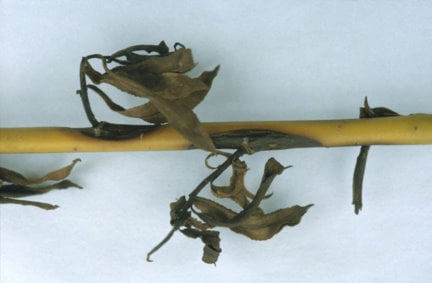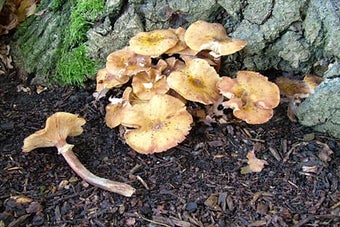
Quick facts
Common name - Willow anthracnose, scab and black canker
Scientific name - Drepanopeziza sphaerioides, Venturia saliciperda and Colletotrichum salicis
Plants affected - Salix
Main causes - Fungi
Timing - Spring to Summer
What are willow anthracnose, scab and canker?
Three fungal pathogens cause leaf spots or blotches and shoot dieback of willow in the UK:
- Drepanopeziza sphaerioides (willow anthracnose) – affecting leaves and stems
- Venturia saliciperda (willow scab) – affecting leaves and stems
- Colletotrichum salicis (willow black canker) – affecting stems only
Symptoms
Anthracnose:
- Brown or black spots appear on the leaves, whose development may be distorted, and irregular raised lesions occur on the young stems. Weeping willow is very susceptible to this disease
- Affected leaves and shoots are often shed, leading to a sparse crown
Scab:
- Irregular black spots appear on new season's growth, causing black, shrivelled shoots
Black canker:
- Symptoms appear later in the season and the shoot dieback is similar to that of scab, but it can spread to older growth where sunken cankers appear on the stem

Control
The RHS believes that avoiding pests, diseases and weeds by good practice in cultivation methods, selection, and encouraging or introducing natural enemies, should be the first line of control. If chemical controls are used, they should be used only in a minimal and highly targeted manner.
Non-chemical control:
- Raking up and destroying fallen leaves from anthracnose-infected trees will only be of limited value, because it is lesions remaining on the tree which are the most important source of infection
- On young trees prune out infected shoots promptly. Damage done by infection is proportionately more severe when the stems are small
Resistance: Salix × sepulcralis var. sepulcralis and S. 'Erythroflexuosa' are resistant to anthracnose, and other willow species are hardly affected. Salix alba var. caerulea, S.pentandra and S. purpurea are resistant to one or both of scab and black canker.
Fungicides
The RHS recommends that you don't use fungicides. Fungicides (including organic types) may reduce , impact soil health and have wider adverse environmental effects. If you do intend to use a fungicide, please read the information given in the links and download below to ensure that use, storage and disposal of the product is done in a responsible and legally compliant manner.
The products listed in the ‘Fungicides for gardeners’ document below are legally available for use by home gardeners in the UK. This information is provided to avoid misuse of legal products and the use of unauthorised and untested products, which potentially has more serious consequences for the environment and wildlife than when products are used legally. Homemade products are not recommended as they are unregulated and usually untested.
There is no specific information available on the efficacy of any home garden fungicide against these willow diseases, and it would not be practicable to spray mature trees in any case.
Download
Fungicides for gardeners (Adobe Acrobat pdf document outlining fungicides available to gardeners)
Link
Biology
The fungi which cause these diseases produce spores on the affected tissues. They are spread in water and the diseases are therefore worst in wet weather. Severe attacks of anthracnose on the very susceptible and commonly planted golden weeping willow (Salix × sepulcralis var. chrysocoma) can leave the tree almost leafless, but the disease is of little consequence on other willows.
Anthracnose differs from scab and black canker by the fact that anthracnose-infected tissues are shed, whereas the shoots killed by the last two diseases remain on the tree. However, not all anthracnose-infected shoots are shed, and those that remain on the tree form the most important source of infection in following years, since the spores they produce are very readily dispersed around the tree in rainwater.




